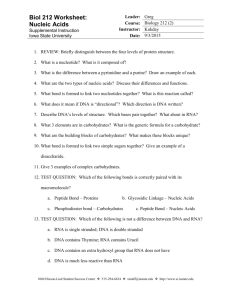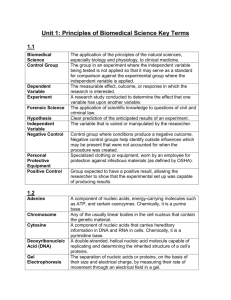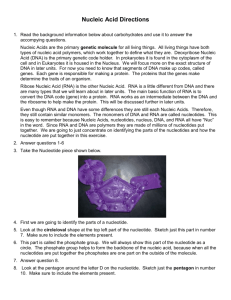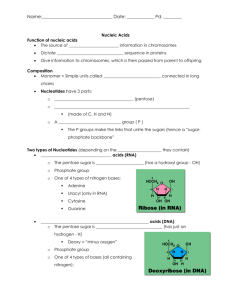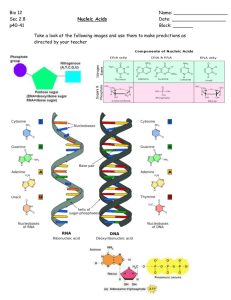B185Syll04(NucleicAcids)
advertisement
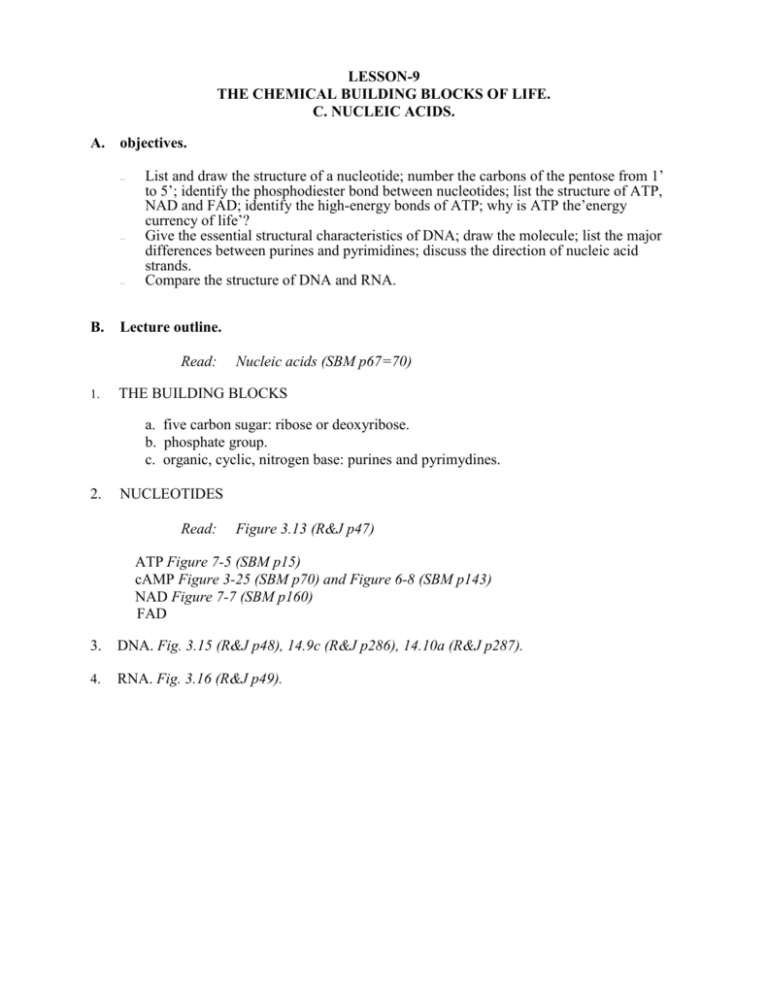
LESSON-9 THE CHEMICAL BUILDING BLOCKS OF LIFE. C. NUCLEIC ACIDS. A. objectives. — — — B. List and draw the structure of a nucleotide; number the carbons of the pentose from 1’ to 5’; identify the phosphodiester bond between nucleotides; list the structure of ATP, NAD and FAD; identify the high-energy bonds of ATP; why is ATP the’energy currency of life’? Give the essential structural characteristics of DNA; draw the molecule; list the major differences between purines and pyrimidines; discuss the direction of nucleic acid strands. Compare the structure of DNA and RNA. Lecture outline. Read: 1. Nucleic acids (SBM p67=70) THE BUILDING BLOCKS a. five carbon sugar: ribose or deoxyribose. b. phosphate group. c. organic, cyclic, nitrogen base: purines and pyrimydines. 2. NUCLEOTIDES Read: Figure 3.13 (R&J p47) ATP Figure 7-5 (SBM p15) cAMP Figure 3-25 (SBM p70) and Figure 6-8 (SBM p143) NAD Figure 7-7 (SBM p160) FAD 3. DNA. Fig. 3.15 (R&J p48), 14.9c (R&J p286), 14.10a (R&J p287). 4. RNA. Fig. 3.16 (R&J p49). C. Study Questions. 1. A nucleotide is composed of: A. a purine and a sugar. B. a pyrimidine and a sugar. C. a phosphate and a sugar. D. sugars and amino acids. E. a pyrimidine or purine, sugar and phosphate. 2. When the phosphate group of one nucleotide binds to the sugar hydroxyl group of another nucleotide, the bond is called a A. glyceride bond. B. ionic bond. C. hydrogen bond. D. peptide bond. E. phosphodiester bond. 3. What cyclic nitrogen base does NOT occur in DNA? A. adenine. B. cytosine. C. guanine. D. thymine. E. uracil 4. What cyclic nitrogen base does NOT occur in RNA? A. adenine. B. cytosine. C. guanine. D. thymine. E. uracil 5. To what carbon of deoxyribose is the cyclic nitrogen base of a nucleotide connected? A. 1’ B. 2’ C. 3’ D. 4’ E. 5’ 6. To what carbon of deoxyribose is the phosphate group of the nucleotide connected? A. 1’ B. 2’ C. 3’ D. 4’ E. 5’ 7. To what sugar carbon of a nucleotide is the next nucleotide attached? A. 1’ B. 2’ C. 3’ D. 4’ E. 5’ 8. The backbone of a nucleic acid is formed by alternating A. sugar and phosphate molecules. B. sugar, phosphate and cyclic N-bases. C. purines and pyrimidines. D. E. 9. ribose and deoxyribose molecules. peptide bonds. To what end of the nucleic acid can new nucleotides be attached? The A. 1’ B. 2’ C. 3’ D. 4’ E. 5’ 10. Cyclic N—bases in which a 6—ring is connected to a 5—ring are called. A. adenines. B. purines. C. guanines. D. pyrimidines. E. cytosines. 11. Cyclic N-bases that contain only a 6-ring are called A. thymines. B. purines. C. cytosines. D. pyrimidines. E. adenines. 12. What nucleotide(s) is(are) (a) purine base(s)? A. adenine. B. thymine. C. guanine. D. cytosine. E. adenine and guanine. F. thymine and cytosine. 13. What nucleotide(s) is(are) (a) pyrimidine base(s)? A. adenine. B. thymine. C. guanine. D. cytosine. E. adenine and guanine. F. thymine and cytosine. 14. What biologically important molecules may contain N atoms? A. carbohydrates. B. lipids. C. proteins. D. nucleic acids. E. proteins and nucleic acids. F. carbohydrates and proteins and nucleic acids. 15. What biologically important molecules contain S atoms? A. carbohydrates. B. lipids. C. proteins. D. nucleic acids. proteins and nucleic acids. E. carbohydrates and proteins and nucleic acids. 16. Whatbiologically important molecules contain P atoms? A. carbohydrates. B. C. D. E. F. lipids. proteins. nucleic acids. proteins and nucleic acids. carbohydrates and proteins and nucleic acids. 17. ATP is an example of a A. sugar B. fatty acid. C. amino acid. D. nucleotide. E. nucleic acid. 18. The number of nucleotides present in NAD equals A. 0. B. 1. C. 2. D. 3. E. 4. 19. This molecule transmits heredity information: A. cholesterol. B. adenosine triphosphate. C. nucleic acid. D. fatty acid. E. polysaccharide. 20. Which of the following statements is false? A. DNA is usually composed of two nucleotide strands. B. DNA contains deoxyribose. C. DNA does not normally contain uracil. D. The nucleotides of DNA are linked by phosphodiester linkages. E. DNA does not normally contain a phosphate group. 21. DNA most directly determines which _______ are made by a cell. A. polysaccharides B. polypeptides C. nucleotides D. triglycerides E. fatty acids 22. Which of the following statements best summarizes the differences between RNA and DNA? A. RNA is a protein and DNA is a nucleic acid. B. DNA is a polymer and RNA is a monomer. C. DNA comprises the genes, while RNA is a direct participant in the process of protein synthesis. D. RNA is a single-stranded form of DNA. E. DNA is the primary energy currency of all cells. 23, 24. Use the figure to answer the corresponding questions. 23. The molecular fragment represented in the accompanying figure is: A. ATP. B. RNA. C. a protein. D. a nucleotide. E. a polysaccharide. 24. The type of connection between the atoms at the point labeled 1 in the accompanying figure is: A. a peptide bond. B. a glycoside linkage. C. a disulfide bond. D. a phosphodiester linkage. E. a hydrogen bond. 25. Analysis of a certain polymer shows that it contains phosphate groups, ribose groups, and pyrimidines. Based on this information, which of the following is the best description of this compound? A. It is most likely ribonucleic acid. B. It is DNA. C. It is an inorganic compound. D. It contains thymine. E. It is a polypeptide. 26. Which pair matches the correct macromolecule with the bond that joins its subunits? A. polysaccharide—peptide bond B. triacylglycerol—glycosidic linkage C. nucleic acid—phosphodiester linkage D. protein—ester linkage E. steroid—peptide bond 27. When a nucleic acid undergoes hydrolysis, the resulting subunits are: A. amino acids B. monosaccharides C. nucleotides D. fatty acids E. carotenoids 28. ATP is important in living organisms because: A. like all other nucleic acids, it stores hereditary information. B. like RNA, it acts as a source code for the formation of proteins. C. it can transfer some of its energy to other chemicals. D. it is an important structural component of cell membranes. E. it is easily converted to starch for long-term storage. 29. Which portion of the following molecule is most directly involved in transferring energy? A. B. C. D. E. 1 2 3 1 and 2 2 and 3 30. Each phosphodiester linkage in DNA or RNA includes a phosphate joined by covalent bonds to A. B. C. D. E. Two bases Two sugars Two additional phosphates A sugar, a base, and a phosphate A sugar and a base True/False 31. By definition, geometric isomers are mirror images of each other. __________________ 32. The carboxyl group can exist in an ionized form and also in a nonionized form. _________________ 33. The phosphate group is a nonpolar group. __________________ 34. Water is always released as a product in hydrolysis reactions. __________________ 35. When glucose and fructose undergo condensation, maltose is produced as a product. _______________ 36. A disaccharide is composed of two monosaccharides joined by a glycosidic linkage. _________________ 37. Glycogen consists of beta-glucose monomers. __________________ 38. Chitin is a polymer composed of N-acetyl glucosamine monomers. __________________ 39. Fats high in unsaturated fatty acids tend to be solid at room temperature. __________________ 40. Carotenoids are composed of isoprene subunits. __________________ 41. An essential amino acid is one that the body cannot synthesize in sufficient amounts. _______________ 42. A beta-pleated sheet is an example of a protein’s tertiary structure. __________________ 43. Molecular chaperones mediate the folding of other protein molecules. __________________ 44. A single protein may have several domains. __________________ 45. A pyrimidine is double-ring molecule. __________________ 46. Cyclic AMP is a type of nucleotide. __________________ Matching Match the molecule with the appropriate word or phrase. a. Carbohydrate c. nucleic acid b. Lipid d. protein 47. most are nonpolar 48. starch 49. consist of monomers having 20 different types 50. a beta-pleated sheet is one typical structure 51. monomers are joined by a glycosidic linkage 52. contains purines and pyrimidines 53. cellulose 54. cholesterol 55. may contain thymine 56. monomers are joined by phosphodiester linkages 57. can be denatured by temperature and/or pH 58. some are composed of fatty acids joined to glycerol

